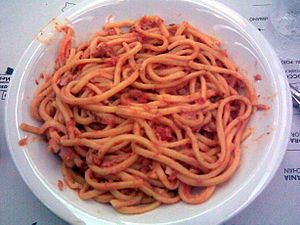Troccoli facts for kids

Troccoli
|
|
| Type | Pasta |
|---|---|
| Place of origin | Italy |
| Region or state | Apulia and Basilicata |
| Main ingredients | Durum wheat flour, eggs (optional) |
Troccoli is a type of pasta that looks a lot like thick spaghetti. It has a special shape, either square or slightly oval, when you look at it from the end. This pasta comes from the Apulia and Basilicata regions in southern Italy.
People often compare Troccoli to another pasta called spaghetti alla chitarra. Both have a similar shape. However, Troccoli is made using a unique tool called a troccolaturo, not the chitarra tool used for spaghetti alla chitarra.
Contents
What is Troccoli Pasta?
Troccoli is a long, thin pasta, similar to spaghetti. It gets its unique shape from how it's made. The dough is cut into strips that are about 3 to 5 millimeters (about 0.1 to 0.2 inches) thick.
When the pasta is made, it gets its square or slightly oval shape. This depends on the grooves of the special tool used. The grooves can be flat or pointy, which changes the final shape of the pasta.
What is Troccoli Made From?
Troccoli pasta is usually made with durum wheat flour and water. Sometimes, a few eggs are added to the dough. Because eggs can be an ingredient, some people think of Troccoli as a type of egg pasta, like tagliolini.
The Troccolaturo Tool
The troccolaturo (or troccolo) is an old kitchen utensil used to make Troccoli pasta. It's a special rolling pin with grooves that cut the pasta dough. This tool has been used in Italy for many centuries.
History of the Troccolaturo
One of the earliest mentions of a tool like the troccolaturo was in 1570. A famous chef named Bartolomeo Scappi wrote about it in his cookbook, Opera dell'arte del cucinare. He called it a "macaroni iron" (ferro da maccheroni). His book even had a picture showing what this old tool looked like.
Back then, the troccolaturo was often made of metal. Over time, people started making it from hardwoods instead. Today, you can find this tool made from both materials, often from beech wood or bronze.
Where Does the Name Troccolaturo Come From?
The names troccolo and troccolaturo come from an old Latin word, torculum. This word means "press" and is related to the verb torquere, which means "to press."
The troccolaturo is a simple, hand-held tool that presses and cuts the pasta dough. It's perfect for making homemade pasta. The pasta itself, Troccoli, is likely named after this special kitchen tool.

